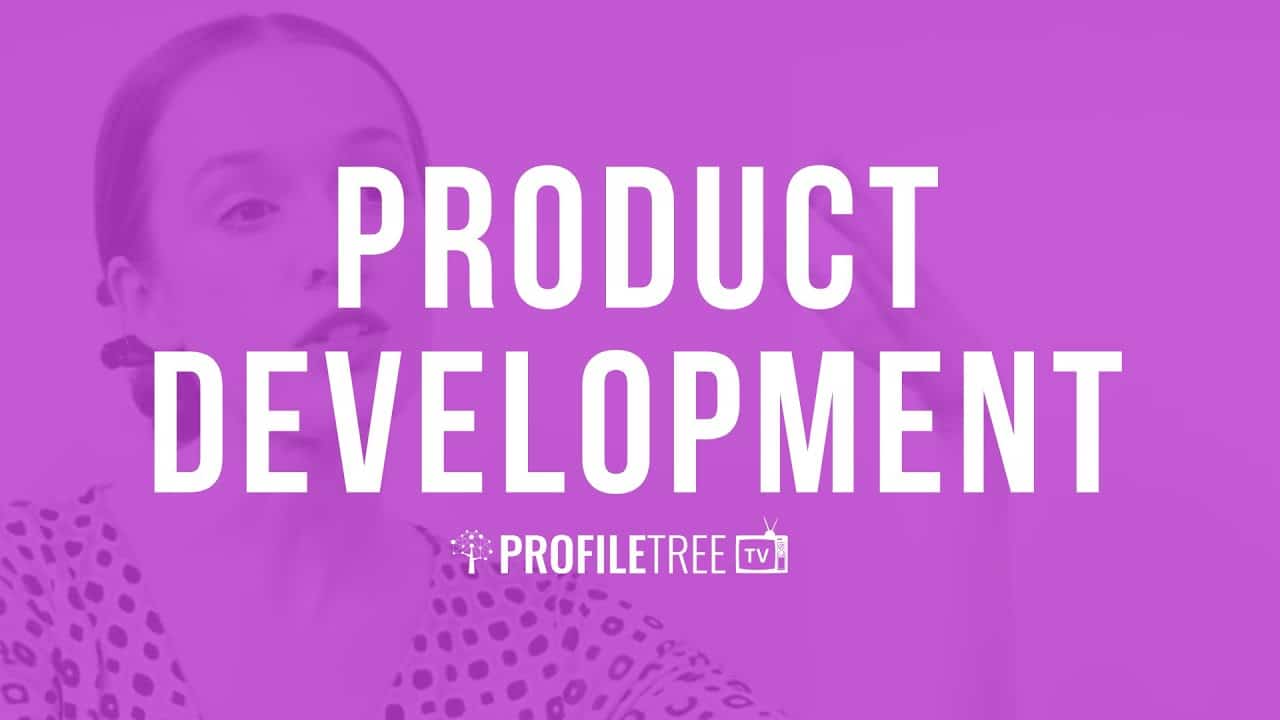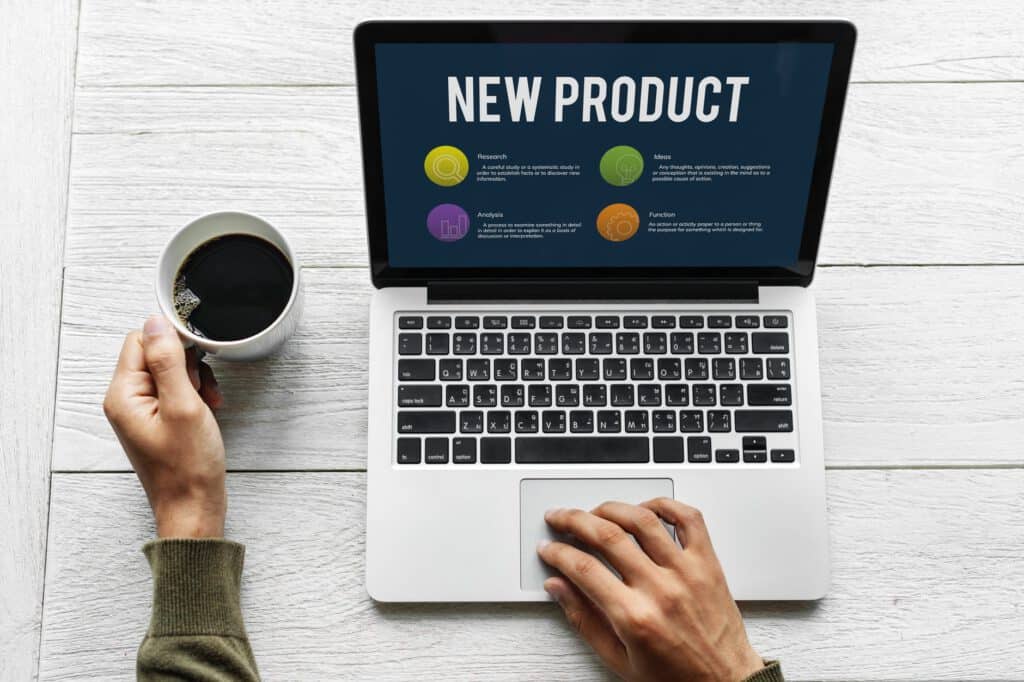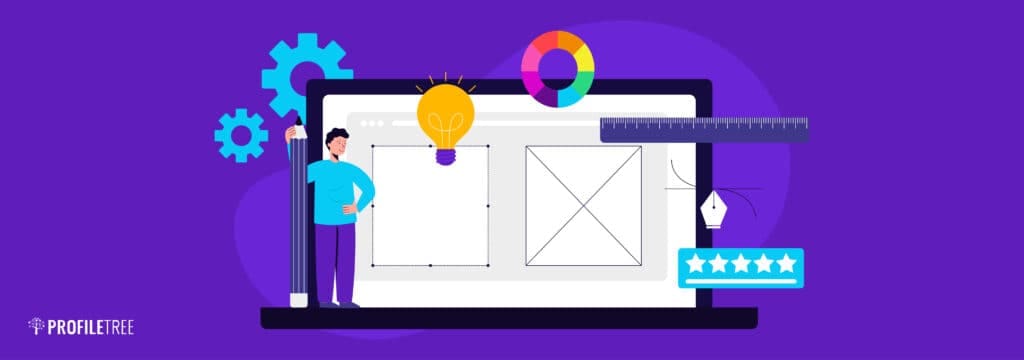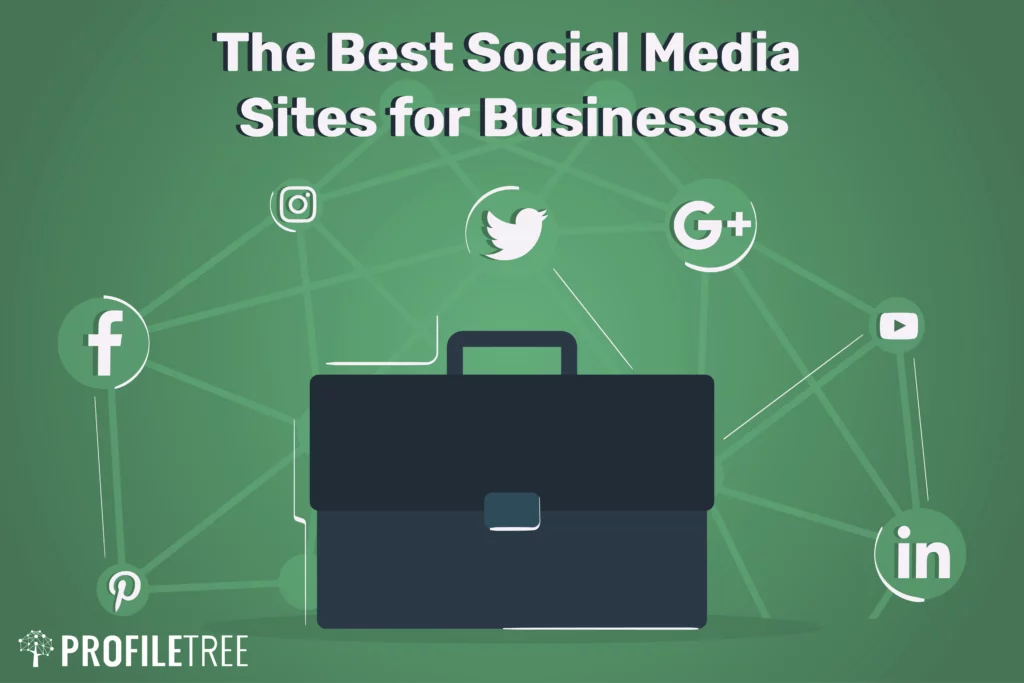What is a Product Development Strategy? ProfileTree Director Michelle Connolly welcomed Bessie Rollins to the ‘PTTV’ studio to take part in our Business Leaders video interview series.
In the bustling marketplace, where ideas swirl and products jostle for attention, success doesn’t happen by chance. It’s a carefully charted course, navigated by a powerful tool: product development strategy.
At its core, product development strategy is the masterplan guiding your journey from brilliant idea to market-dominating reality. It’s the invisible map that charts the course between your target audience’s needs and the features that will fulfill them. It’s the lighthouse in the storm of competition, illuminating the path to a distinctive and impactful product.
But why is a strategy so crucial in this creative endeavor? Imagine an inventor tinkering away in their garage, crafting a magnificent gadget, yet oblivious to whether anyone craves it. Or picture a team pouring resources into a product that, although technically flawless, fails to resonate with a single customer. This, without a defined strategy, is the perilous path to disappointment, wasted resources, and abandoned dreams.
A well-defined product development strategy acts as your compass, ensuring you:

- Align with your target audience: You understand their desires, pain points, and motivations, crafting a product that fits seamlessly into their lives.
- Navigate the competitive landscape: You identify your rivals, analyze their strengths and weaknesses, and plot a course to differentiate yourself and carve your own niche.
- Optimize resource allocation: You invest time, talent, and budget wisely, focusing on the features that deliver maximum impact.
- Reduce uncertainty and minimize risk: You anticipate challenges, test assumptions, and iterate quickly, minimizing costly mistakes and maximizing your chances of success.
Bessie, the founder of Modern Nature, gave insights into her experience in the food industry and explained how product development had helped her to build the business she had dreamed of.
Bessie outlined the value of ‘Stevia’ a plant-based product Bessie used in the past and which gave her inspiration for her own line of cooking products. She also explained the work of her own company.
Table of Contents
What is a Product Development Strategy? Talking Products with Bessie Rollins
“Modern Nature make low sugar, sugar-free and reduced sugar consumables. At the moment we have a liquid Stevia sweetener, sugar-free coffee syrups and are soon to be launching a new granulated Stevia sweetener. We’re working on a range of hot chocolates that will be coming in the next year or so.
“The background was mainly my health as I have a generic blood condition that makes me more likely to develop diabetes and I started to become unwell with my condition at 17, but wasn’t diagnosed until I was 22. Within that time I developed pre-diabetes and severe IBS. That was how I became interested in health and healthy living. The main reason was to reverse my pre-diabetes and IBS, which I now have done.
“I used Stevia to help and that’s how I discovered Stevia.”
At the time Stevia was “incredibly expensive for a tiny bottle and was really hard to get a hold of”. This gave Bessie the idea to make Stevia products more accessible to the UK market and consumers due to there being little or no Stevia options available.
“Stevia is a plant, so it is naturally sweet. It is native to Paraguay and South America and actually grows naturally throughout South America, all the way up to Texas.”
Bessie explained the product development side of Modern Nature, from concept to the shop shelves.
“We buy from a very reliable supplier, they manage the farm, it is harvested by them and they go through the extraction process. We’re lucky we have a very reliable source with a consistent price.
“Coming up with a recipe is quite straightforward it is then testing it which takes quite a long time. It has to go through shelf life.
“Our bottle is custom, it is bespoke design, so we had to get a tool made.
“When it comes to packaging, you do need to buy in quantity, but in smaller amounts. We had an issue where we bought loads of labels and we changed the ingredients slightly, so we can’t use it.
“Don’t fork out for stock you don’t need. Get it right the first time and be happy with it!”
Owning a food product/brand comes with its struggles, Bessie gave an great example: “We had the biggest hu ha with our packaging. we had to, last minute, re-develop our outer packaging, because our suppliers became difficult. And I just said nope, we’re not doing that. We had to come up with a complete new solution. You need to make tough calls.”
To discover more see Bessie Rollins’ full video interview..
Modern Nature – www.modernnature.io

The importance of market research, customer data analysis, and using data to inform product decisions
In the age of information overload, successful product development isn’t just about brilliant ideas; it’s about harnessing the power of data-driven insights. Gone are the days of gut-feeling guesses and wishful thinking. Today, the winners in the marketplace are those who listen to the whispers hidden within the data, translating them into actionable strategies that turn concepts into customer-loved products.
Think of data as your treasure trove, brimming with invaluable nuggets of information about your target audience, their needs, and their behaviors. Market research uncovers trends, reveals unmet desires, and paints a vivid picture of the landscape you’re about to enter. Customer data analysis whispers in your ear, sharing intimate details about how they interact with your existing products, highlighting pain points and hidden opportunities.
But data, like raw ore, needs refining to reveal its true worth. Here’s how you can transform data into the fuel that propels your product development journey:
- Identify market gaps: Analyze market research and customer data to pinpoint unmet needs and underserved niches. Is there a functionality missing in existing products? A customer segment yearning for a specific solution? Finding these gaps is where innovation sparks.
- Shape your product offering: Leverage data to prioritize features and functionalities that resonate most with your target audience. Is a bells-and-whistles approach the solution, or will streamlined simplicity win hearts? Data reveals the preferences that guide your development roadmap.
- Personalize the experience: Data isn’t just about broad strokes; it’s about understanding individual customers. Analyze user behavior data to personalize features, tailor marketing messages, and deliver experiences that feel tailor-made for each user.
- Measure and iterate: Data doesn’t rest, and neither should your product. Use analytics to track performance, identify areas for improvement, and continuously refine your offering based on real-world feedback. Remember, data is a conversation, not a monologue.
Agile vs Waterfall: Choosing the Right Flow for Your Product Development River
When it comes to navigating the development river, two main currents prevail: the agile rapids and the waterfall cascade. Choosing the right flow depends on your boat’s size, the river’s terrain, and your desired pace. So, let’s dive into the pros and cons of each approach, tailoring them to different business needs:
Agile:
Pros:
- Adapt to change: Embraces iterative cycles, allowing you to pivot quickly based on feedback, ideal for volatile markets or rapidly evolving technologies.
- Prioritize customer needs: Features can be prioritized and prioritized based on user insights, ensuring you’re building something people want.
- Reduce risk: Frequent testing and delivery minimize the investment in potentially flawed features before widespread release.
- Team collaboration: Fosters cross-functional collaboration and open communication, leading to a more engaged and invested team.
Cons:
- Requires a dedicated mindset: Demands cultural shift for teams accustomed to rigid planning, and may not thrive in hierarchical environments.
- Uncertainty can be unsettling: Lack of fixed timelines and scope can feel chaotic for some stakeholders.
- Documentation can lag: Focus on rapid iteration can lead to incomplete documentation, creating challenges for onboarding new team members.
Ideal for:
- Startups and innovative projects with high uncertainty and rapid change.
- Products with dynamic functionality or frequent market shifts.
- Teams comfortable with flexibility and open to adapting to new information.
Waterfall:
Pros:
- Structured and predictable: Clear roadmap and milestones provide a defined plan for stakeholders and investors.
- Thorough upfront planning: Fewer surprises due to comprehensive requirements gathering and documentation.
- Efficient for stable environments: Works well for well-defined projects with minimal need for iterative changes.
- Focus on quality: Linear progression allows for focused testing and refinement at each stage.
Cons:
- Less adaptable to change: Pivoting can be expensive and time-consuming due to pre-built stages and dependencies.
- Delayed user feedback: Features get locked in early, potentially missing valuable user insights for later stages.
- Potential for siloed teams: Less emphasis on collaboration can lead to communication gaps between different groups.
- Higher risk upfront: Large initial investment before testing might lead to wasted resources if the product misses the mark.
Ideal for:
- Large, well-defined projects with clear requirements and minimal anticipated change.
- Products with established markets and predictable user needs.
- Teams accustomed to structured environments and sequential workflows.
Remember, the choice isn’t binary. Hybrid approaches that combine elements of both Agile and Waterfall can also be effective depending on your specific project and needs.
Prototyping and MVPs: Testing the Waters Before Diving into the Product Ocean
Imagine building a majestic ship only to discover, upon setting sail, that it capsizes with the slightest wave. The world of product development, thankfully, offers a life-saving raft: prototyping and Minimum Viable Products (MVPs). These are not miniature versions of your final product; they’re crucial tests, early sketches on the canvas of reality, allowing you to validate your ideas and course-correct before pouring in resources.
Prototyping is the artist’s rough draft, a tangible way to visualize your concept. It can be a low-fidelity sketch, a cardboard mockup, or a basic clickable wireframe. The key is to quickly and cheaply give form to your idea, allowing you to:
- Test core functionalities: See if your concept actually solves the problem you identified. Do users understand the flow? Does the value proposition resonate?
- Gather early feedback: Get real-world reactions from potential users, identifying usability issues and pain points before investing in full development.
- Identify potential roadblocks: Uncover technical challenges or unforeseen complexities early on, giving you time to adjust your course.
But a prototype alone is just a sketch on the wall. To truly test the waters, you need to launch it into the real world with an MVP, a stripped-down version of your final product with just the core features. Think of it as a small fishing boat venturing out to assess the catch. By releasing an MVP:
- Validate market demand: Gauge user interest and willingness to pay for your solution before significant investment.
- Learn from usage patterns: Observe how users interact with your MVP, gaining valuable insights for refining the final product.
- Iterate and improve: Use gathered feedback to continuously improve your offering, ensuring you build something people truly want and need.
The beauty of prototyping and MVPs lies in their fail-fast philosophy. It’s better to test your idea quickly and cheaply, learn from its flaws, and pivot if needed, than to pour resources into a full-fledged product that misses the mark entirely. Think of it as building a bridge piece by piece, testing each step before committing to the entire span.
The Art of the Invisible Hand: Why UX and UI Design Are the Unsung Heroes of Product Success

In the bustling marketplace, products scream for attention, each vying for a coveted spot in our lives. But beyond the alluring features and flashy marketing, a silent force shapes our experience: User Experience (UX) and User Interface (UI) design. These are the invisible hands crafting the stage upon which your product performs, the architects of the journey users take when interacting with your creation.
UX design weaves threads of empathy and logic, understanding users’ needs, motivations, and mental models to create a seamless and intuitive flow. It asks, “how does this product make the user’s life easier, simpler, and ultimately, more enjoyable?” It’s the invisible architect, ensuring every click, swipe, and tap feels effortless and natural.
UI design then paints the stage with aesthetics and functionality. It translates the UX vision into tangible pixels and buttons, crafting interfaces that are not just visually appealing, but also clear, consistent, and discoverable. Imagine the UI as the artist’s brushstrokes, bringing the user experience to life with elegance and purpose.
But their impact goes beyond mere aesthetics. Excellent UX and UI design are strategic investments, reaping tangible rewards:
- Increased user adoption and engagement: Users who find your product intuitive and pleasurable to use are more likely to keep coming back, boosting engagement and loyalty.
- Reduced support costs: A well-designed interface minimizes confusion and frustration, leading to fewer support tickets and saving you valuable resources.
- Improved brand perception: A product that’s a joy to use becomes an ambassador for your brand, generating positive word-of-mouth and fostering trust.
- Competitive advantage: In a crowded market, an intuitive and well-designed product stands out, attracting customers and leaving the competition in the dust.
Remember, neglecting UX and UI is like building a beautiful mansion with a labyrinthine entryway. Users might eventually find their way in, but the experience leaves a lasting impression. By investing in these crucial aspects, you ensure your product not only looks stunning, but feels like a smooth, welcoming invitation to explore its potential.
Diving Deep: Finding Your Treasure in the Minimum Viable Market (MVM)
Imagine diving into an ocean of potential customers, searching for your prized catch: the Minimum Viable Market (MVM). This isn’t about casting a wide net and hoping for the biggest haul; it’s about pinpointing the smallest, most crucial group where your product solves a critical problem they face. Think of it as discovering the hidden reef teeming with vibrant life, a microcosm of the broader market where your product can truly flourish.
The MVM isn’t just about numbers; it’s about focus. It’s about identifying the early adopters, the passionate pioneers who resonate deeply with your value proposition and become your initial champions. These are the users who provide invaluable feedback, shaping your product as it evolves and paving the way for wider market adoption.
So, how do you find your MVM?
- Deep dive into your target audience: Understand their needs, desires, and pain points. Segment your audience based on demographics, behaviors, and motivations.
- Identify underserved niches: Look for pockets within your audience where existing solutions fall short. These are your treasure chests waiting to be unlocked.
- Focus on critical problems: Don’t try to solve everything for everyone. Find the single, most pressing issue your product can tackle for this specific group.
- Validate your MVM: Test your assumptions with interviews, surveys, and early prototypes. Get your target audience talking, and listen intently to their reactions.
Remember, the MVM is just the first step. Once you’ve found your loyal reef and proven your product’s value, you can gradually expand your reach to larger segments of the market. The insights and feedback gained from your MVM will guide your development, ensuring you build a product that solves real problems for real people, not just chasing imaginary market shares.
Here are some examples of successful MVMs:
- Airbnb: Initially focused on vacation rentals for tech conference attendees, a niche market with a specific need.
- Dropbox: Started with early adopters in technology who craved a seamless file sharing solution.
- Zappos: Launched by catering to shoe enthusiasts, a passionate group with high expectations.
Embracing Challenges and Opportunities in a Growing Product Landscape
Building a successful product is like climbing a mountain – exhilarating, rewarding, but fraught with its own set of challenges. Reaching the peak is one thing, but conquering the vast vista beyond requires a different set of skills. This is where scaling and future considerations come into play, guiding your product’s journey from a vibrant sapling to a towering redwood.
Challenges, like treacherous terrains, demand strategic navigation:
- Infrastructure bottlenecks: As your user base grows, your tech infrastructure can strain, requiring upgrades and optimizations to maintain smooth performance.
- Team expansion and alignment: Onboarding new talent and maintaining cross-functional collaboration becomes crucial to sustain the pace of innovation and product growth.
- Market shifts and evolving needs: Customer preferences and competition are never static. Adapting to changing trends and emerging needs requires agility and constant reinvention.
- Managing costs and profitability: Balancing rapid growth with financial sustainability necessitates careful resource allocation and efficient scaling strategies.
But amidst these challenges lie hidden opportunities, shimmering like sunlit peaks on the horizon:
- Increased market reach and revenue potential: A larger user base opens doors to new markets, partnerships, and revenue streams, fueling further growth.
- Data-driven insights and optimization: With more user data, you can refine your product, personalize experiences, and make data-driven decisions for continued success.
- Brand recognition and influence: A well-scaled product fosters brand loyalty and advocacy, creating a powerful network of users and amplifying your market reach.
- Building a resilient and adaptive culture: Navigating scaling challenges fosters a culture of innovation, problem-solving, and adaptability, preparing your team for future successes.
To embrace these opportunities and weather the challenges, consider these essential tools:
- Future-proof architecture: Invest in scalable infrastructure and technologies that can accommodate future growth without performance hiccups.
- Data-driven decision making: Leverage user data to identify growth opportunities, predict trends, and personalize your product to retain and attract customers.
- Agile and adaptable processes: Embrace flexible methodologies and cross-functional collaboration to respond quickly to market changes and customer feedback.
- Talent acquisition and development: Foster a culture of learning and growth within your team, equipping them with the skills needed to navigate the scaling journey.
FAQ
Q: What is the difference between agile and waterfall development methodologies?
A: Agile is iterative and adaptable, prioritizing rapid cycles and user feedback. Waterfall is more structured and sequential, focusing on upfront planning and comprehensive requirements gathering. Choose agile for volatile markets and rapid change, and waterfall for well-defined projects with minimal anticipated change.
Q: How can I find my Minimum Viable Market (MVM)?
A: Deeply understand your target audience, identify underserved niches, focus on critical problems your product solves, and validate your MVM with interviews, surveys, and early prototypes. Remember, it’s about finding a small, dedicated group where your product truly makes a difference.
Q: What metrics should I track to measure product success?
A: Monitor market awareness, website conversions, customer acquisition cost, lifetime value, user engagement, and retention. Analyze these metrics regularly to refine your product, marketing, and sales strategies.
Q: How can I prepare my product for future market changes?
A: Invest in scalable infrastructure, adopt data-driven decision-making, embrace agile processes, and foster a culture of learning and adaptability within your team. By anticipating challenges and seizing opportunities, you can ensure your product thrives in an ever-evolving landscape.
Conclusion
Building a successful product is a dynamic journey, demanding strategic planning, unwavering effort, and a spirit of constant evolution. This article has equipped you with a roadmap, highlighting the key elements that guide your product from conception to market domination.
Remember, the path is paved with challenges and opportunities, but by harnessing the power of data-driven insights, fostering strategic alliances, and embracing adaptability, you can transform your product from a fleeting idea into a beacon of innovation, leaving a lasting impact on the world around you. Now, step into the arena of innovation, embrace the challenges, and watch your product scale the heights of success.
Business Interviews:
Two Years to £27 Million | Should Your Business be Concerned about Brexit? | The Business Mindset | Workplace Wellness | What is Company Culture? | Business Broadband NI | How to do Business Internationally? | Do you have a HR Strategy? | What is Innovation? | What is a Business Development Manager? | Importance of HR | Accounting Strategy
Different Business Types:
What is a Franchise Business? | FitzWilliam Hotel Belfast | Newspaper Marketing Trends | Discussing Product Development
Personal Development:
The ‘PROVE IT’ Guy | Performance Consultant and Speaker | How to Build Self-Confidence | What is NLP Therapy? | Feel Good Hypnosis
Marketing:
How to use Psychology Marketing? | What is Growth Hacking?
Technology:
Augmented Reality in Education | Why is Technology Important in Business?


